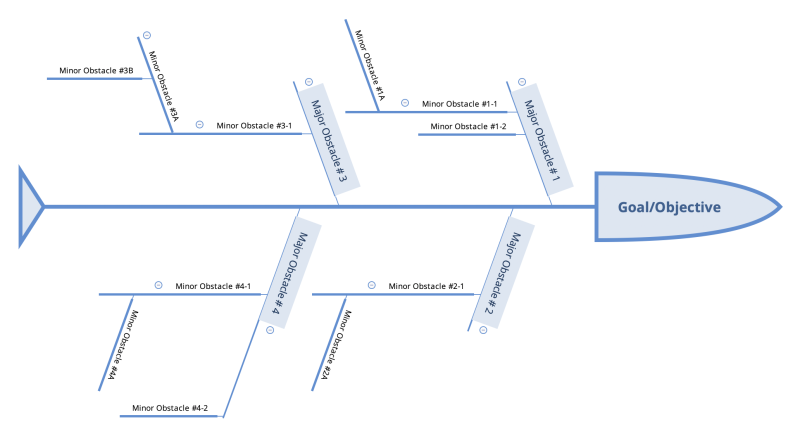Table of Contents
Tactical Planning Support
What is Tactical Planning?
After a “Strategic Plan” is developed, a “Tactical Plan” is a structured approach to achieving its objectives.
A “Strategic Plan” is developed by management identifying the long-term (e.g., 1-5 year) objectives for the business.
A “Tactical Plan” is developed to identify the specific actions needed in order to achieve a strategic objective.
Why Do Companies Need Tactical Planning?
Thomas Edison said, “Vision Without Implementation Is Hallucination”.
Far too often, executive management establishes strategic objectives without fully considering all of the actions necessary to achieve them. Consequently, when management unexpectedly encounters obstacles that appear difficult to overcome, the “Strategic Plan”, developed with the best of intentions, ends up languishing on a shelf.
While many management books focus on strategic planning, there are very few books addressing the challenges of implementing the strategic plan.
A “Tactical Plan”, coupled with implementation activities, allows management to identify obstacles, break them down, and overcome them at a continuous pace. When management monitors the progress being made toward its objectives, adjusting actions as needed, they're inspired to continue pursuing each objective through to completion.
Randall's Approach to Tactical Planning
Randall offers a unique approach toward “Tactical Planning” by utilizing a variation of “Fishbone” diagram (the Ishikawa diagram) where the “head” of the “fishbone” is a strategic objective rather than a problem. And the “bones” are “obstacles” to the objective, rather than the causes of a problem.
 Randall's “Tactical Planning” sessions are focused on assisting companies in defining pathways to achieve a small number of major goals during a short period of time. As a minimum, objectives should be annual, but ideally, are quarterly objectives.
Randall's “Tactical Planning” sessions are focused on assisting companies in defining pathways to achieve a small number of major goals during a short period of time. As a minimum, objectives should be annual, but ideally, are quarterly objectives.
Randall requests management to define 2 or 3 major objectives to be achieved during a specific time frame. Randall then hosts a full-day meeting with the management team to perform a “root cause” analysis identifying obstacles preventing the company from achieving those goals. Once the “root causes” are identified, SMART action items are created to remove those obstacles. Once focused on the goals, and with the obstacles clearly identified, most companies experience short-term growth at a greatly accelerated pace.
Using this approach, one organization was able to achieve ALL of the objectives in their 1-year “Strategic Plan” in only 4 months! The President of the organization was astounded. And the exercise was immediately repeated in order to take the organization even further.
The Tools
The tools are simple. All one needs is a:
- Fishbone Diagramming application (tool), and a
- SMART Task template
One of the easiest Fishbone Diagramming tools is provided in XMind 8 (the free version works fine). While there are other applications available for easily creating a Fishbone Diagram, beware of the temptation of “Maslow's Hammer” (overuse or misuse of a familiar tool). For example, some people have attempted to use Excel to create a Fishbone Diagram. This results in a cumbersome and inefficient approach.
While there are some variations in the acronym, SMART tasks are:
- Specific (i.e., defining/detailing the task that is to be completed);
- Measurable (i.e., with clear goals expressed as quantitative or digital values);
- Assigned (i.e., to one or more specific individuals possessing the required KSA - Knowledge, Skills & Abilities);
- Resourced (e.g., allocated the required equipment & supporting personnel to achieve the objective), and
- Time-specific (e.g., due dates, time or event-driven milestones, Gantt chart).
Preparing for the Tactical Planning Event
While the tools are simple, the “real” challenges in Tactical Planning are:
- establishing realistic (achievable) goals/objectives
- having the “right” people involved (from the areas/departments/functions necessary to affect the desired change)
- having people who are capable of “critical” thinking
The first order of business is to assign/designate a:
- Event Leader; to coordinate the activity… keeping the group focused on its objectives.
- Secretary; to record the obstacles preventing the goal/objective from being achieved (in the Fishbone diagram application)
The event may be performed online (remotely) or in person. Both approaches have advantages and disadvantages.
Regardless of how the event is held, the Fishbone diagram should be shared on-screen (or on an overhead projector) during the event so that everyone is aware of the obstacles being identified.
The Tactical Planning Event
The event begins with management identifying a goal/objective (which should be decided prior to the Strategic Planning event).
Next, the group is asked a pointed question… “What are the obstacles preventing us from achieving this goal/objective?”.
The Event Leader must emphasize that this is NOT a “brainstorming” session. Allowing the session to devolve into an uncoordinated “brainstorming” session will result in random ideas leading to the group losing focus on the purpose of the event. defeats the purpose. The group leader can get “back on track” by asking specific individuals specific questions such as “What do you view as obstacles in your area/department/function preventing us from achieving this goal/objective? And what do you need in order to eliminate that obstacle?”. Care should be taken to ensure that the questions are focused on finding solutions rather than placing blame.
As obstacles are identified, these are entered into the Fishbone diagram as “Major Obstacles”. Once a Major Obstacle has been identified, the questions should shift to “And what obstacles are preventing us from eliminating that obstacle?”. This line of investigative questioning is similar to the “5 Whys” used in root cause analysis. However, the purpose is shifted to identifying the contributing obstacles rather than attempting to understand why they exist.


